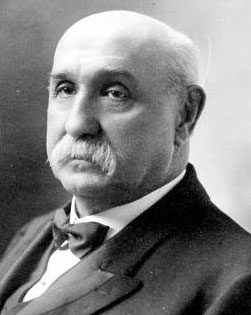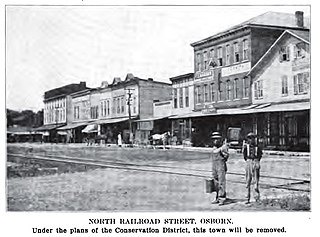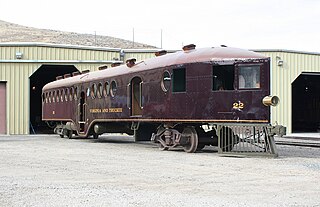
A railcar is a self-propelled railway vehicle designed to transport passengers. The term "railcar" is usually used in reference to a train consisting of a single coach, with a driver's cab at one or both ends. Some railway companies, such as the Great Western, termed such vehicles "railmotors".

James Jacob Ritty, saloonkeeper and inventor, opened his first saloon in Dayton, Ohio in 1871, billing himself as a "Dealer in Pure Whiskies, Fine Wines, and Cigars." Some of Ritty's employees would take the customers' money that was meant to pay for the food, drink, and other wares. In 1878 while on a steamboat trip to Europe, Ritty became intrigued by a mechanism that counted how many times the ship's propeller went around. He wondered whether something such as this could be made to record the cash transactions made at his saloon.

Osborn was a town located near the Haddix Road-Ohio 235 intersection at the northern edge of Wright-Patterson Air Force Base in what is now the flood-prone basin of the Huffman Dam in the U.S. state of Ohio.

British Rail produced a variety of railbuses, both as a means of acquiring new rolling stock cheaply, and to provide economical services on lightly used lines.

ACF Industries, originally the American Car and Foundry Company, is an American manufacturer of railroad rolling stock. One of its subsidiaries was once (1925–54) a manufacturer of motor coaches and trolley coaches under the brand names of (first) ACF and (later) ACF-Brill. Today, the company is known as ACF Industries LLC and is based in St. Charles, Missouri. It is owned by investor Carl Icahn.
The St. Louis Car Company was a major United States manufacturer of railroad passenger cars, streetcars, interurbans, trolleybuses and locomotives. It operated from 1887 to 1974 and was based in St. Louis, Missouri.

The Budd Rail Diesel Car (RDC), also known as the Budd car or Buddliner, is a self-propelled diesel multiple unit (DMU) railcar. Between 1949 and 1962, 398 RDCs were built by the Budd Company of Philadelphia, Pennsylvania, United States. The cars were primarily adopted for passenger service in rural areas with low traffic density or in short-haul commuter service, and were less expensive to operate in this context than a traditional diesel locomotive-drawn train with coaches. The cars could be used singly or coupled together in train sets and controlled from the cab of the front unit. The RDC was one of the few DMU trains to achieve commercial success in North America. RDC trains were an early example of self-contained diesel multiple unit trains, an arrangement now in common use by railways all over the world.

The Pioneer Zephyr is a diesel-powered trainset built by the Budd Company in 1934 for the Chicago, Burlington & Quincy Railroad (CB&Q), commonly known as the Burlington Route. The trainset was the second internal combustion-powered streamliner built for mainline service in the United States, the first such train powered by a diesel engine, and the first to enter revenue service.

The J. G. Brill Company manufactured streetcars, interurban coaches, motor buses, trolleybuses and railroad cars in the United States for nearly 90 years, hence the longest-lasting trolley and interurban manufacturer. At its height, Brill was the largest manufacturer of streetcars and interurban cars in the US and produced more streetcars, interurbans and gas-electric cars than any other manufacturer, building more than 45,000 streetcars alone.

Fageol Motors was a United States manufacturer of buses, trucks and farm tractors.

Carillon Historical Park is a 65-acre park and museum in Dayton, Ohio, which contains historic buildings and exhibits concerning the history of technology and the history of Dayton and its residents from 1796 to the present. As a part of the University of Dayton, the historical elements of the park were the brainchild of Colonel Edward Deeds. The major sections include settlement, transportation, invention, and industry. The park also contains the Carillon Park Railroad, a 7+1⁄2 in gauge miniature railway.
The Railway Museum of Greater Cincinnati is a railroad museum in Covington, Kentucky.

Harlan & Hollingsworth was a Wilmington, Delaware, firm that constructed ships and railroad cars during the 19th century and into the 20th century.

The Historic Railpark and Train Museum, formerly the Louisville and Nashville Railroad Station in Bowling Green, Kentucky, is located in the historic railroad station. The building was placed on the National Register of Historic Places on December 18, 1979. Opened in 1925, the standing depot is the third Louisville & Nashville Railroad depot that served Bowling Green.
Avalon Rail Inc. was a passenger railcar restoration and rebuilding company in West Allis, Wisconsin, United States, a community near Milwaukee. June Garland was the company's president.
The Midwest Electric Railway is a non-profit trolley operation located on the grounds of the Midwest Old Threshers Reunion in Mt. Pleasant, Iowa, United States. It is home to 10 pieces of trolley history that are regularly operated on a 2.5 mile loop surrounding the organization's campgrounds.
A railroad chapel car is a mobile railroad car used to provide religious services and information. The car also serves as living quarters for the pastor. The front of the car is designed to act as a "church on wheels" with an altar, pew, and in some cases, stained glass windows.

Virginia and Truckee Railway Motor Car 22, also called McKeen Motor Car 70, is a gasoline-powered railcar at the Nevada State Railroad Museum in Carson City in the U.S. state of Nevada. It was built for the Virginia and Truckee Railroad in 1910 by the McKeen Motor Car Company. Motor Car 22 was operated by the Virginia and Truckee until 1945, when it was sold off and became a diner until 1955. It eventually became the office and storage space for a plumbing business before it was donated to the Nevada State Railroad Museum in 1995. After a thorough study, the Museum undertook a restoration of the McKeen car in 1997. The restored motor car was unveiled in 2010, a century after it was originally delivered to the Virginia and Truckee. Motor Car 22 was listed on the National Register of Historic Places in 2005, and designated a National Historic Landmark in 2012. It is one of a few surviving McKeen railcars, and the only one that is operational.

The Gallery Car is a bilevel rail car, originally created by the Pullman Company as the Pullman Gallery Car. It has had five total different manufacturers since its creation, including Budd, St. Louis Car Company, Amerail, Nippon Sharyo and Canadian Vickers. These double-decker passenger car were built by Pullman-Standard during the 1950s to 1970s for various passenger rail operators in the United States.
















